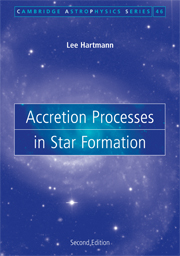Book contents
- Frontmatter
- Contents
- Preface to the first edition
- Preface to the second edition
- Acknowledgments
- 1 Overview
- 2 Beginnings: molecular clouds
- 3 Initial conditions for protostellar collapse
- 4 Protostellar cloud collapse
- 5 Protostellar collapse: observations vs. theory
- 6 Binaries, clusters, and the IMF
- 7 Disk accretion
- 8 The disks of pre-main-sequence stars
- 9 The FU Orionis objects
- 10 Disk winds, jets, and magnetospheric accretion
- 11 Disk accretion and early stellar evolution
- 12 Disk evolution and planet formation
- Appendix 1 Basic hydrodynamic and MHD equations
- Appendix 2 Jeans masses and fragmentation
- Appendix 3 Basic radiative transfer
- List of symbols
- Bibliography
- Index
9 - The FU Orionis objects
Published online by Cambridge University Press: 30 October 2009
- Frontmatter
- Contents
- Preface to the first edition
- Preface to the second edition
- Acknowledgments
- 1 Overview
- 2 Beginnings: molecular clouds
- 3 Initial conditions for protostellar collapse
- 4 Protostellar cloud collapse
- 5 Protostellar collapse: observations vs. theory
- 6 Binaries, clusters, and the IMF
- 7 Disk accretion
- 8 The disks of pre-main-sequence stars
- 9 The FU Orionis objects
- 10 Disk winds, jets, and magnetospheric accretion
- 11 Disk accretion and early stellar evolution
- 12 Disk evolution and planet formation
- Appendix 1 Basic hydrodynamic and MHD equations
- Appendix 2 Jeans masses and fragmentation
- Appendix 3 Basic radiative transfer
- List of symbols
- Bibliography
- Index
Summary
The remarkable eruptive FU Orionis objects found in star-forming regions are important to our understanding of protostellar accretion disk physics. The best-studied FU ors provide the clearest examples of the SED of an optically-thick accretion disk, with observations spanning a decade in wavelength or more. The very high accretion rates of these accretion disk systems imply that the MRI can easily operate through thermal ionization, at least out to radial distances of nearly an AU. In addition, the high temperatures mean that gaseous spectral lines are present which can be used to infer rotation, turbulence, disk surface mass ejection (Chapter 10), and even chromospheric activity. Clues to the magnitude of angular momentum transport can be derived from the timescales of variability of these systems. Finally, the eruptive behavior and high accretion rates for short periods of time provide an unexpected insight into how mass is added to stars during early stellar evolution.
Acceptance of the accretion disk model proposed by Paczynski (1976), Lin and Papaloizou (1985), and Hartmann and Kenyon (1985) was slowed by the optical appearance of FUors, with spectra similar to that of a G supergiant (except rapidly rotating, an otherwise unknown set of objects). An early model for FUors attempted to explain the substantial near-infrared excesses (Cohen & Woolf 1971; Rieke et al. 1972; Simon et al. 1972; Grasdalen 1973; Simon 1975) by invoking such rapid rotation that the equatorial regions were much more extended, and thus cooler, than the polar regions (Mould et al. 1978).
- Type
- Chapter
- Information
- Accretion Processes in Star Formation , pp. 188 - 212Publisher: Cambridge University PressPrint publication year: 2008



